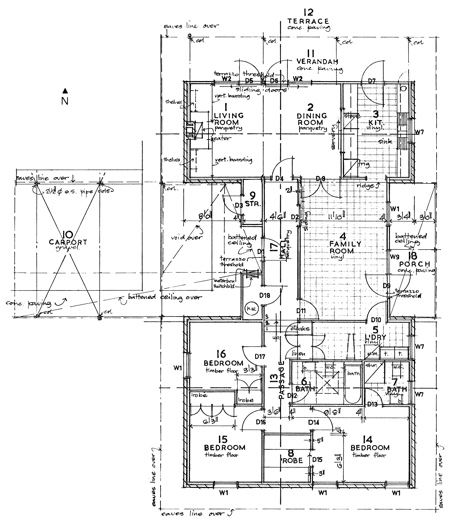Woden Special Housing I, Kent Street, Hughes (1963)
Woden Special Housing I is a group of 12 houses at 151-163 Kent Street, Hughes designed by John Taylor of Leith & Bartlett for the National Capital Development Commission (NCDC) in April 1963. Construction was completed early in 1964. The houses were the first to be built in the newly created satellite town of Woden Valley.
Significance
The houses are aesthetically significant for their unpretentious, simple proportions and fine detailing. They exhibit the principal characteristics of modern residential architecture in a planned neighbourhood suburb context: well sited with appropriate human scale and functional domestic planning. The houses have special interest in being an unusual example of a coherent group of houses designed in the Post-War Melbourne Regional style of architecture. As a group, they remain illustrative of modern architecture from the early 1960s.
They are also a rare intact example of a housing group designed by the NCDC for senior government staff—a number of whom were prominent Australians (see below). They were intended as a showcase to attract people to the newly established suburb of Hughes, the first suburb of Woden Valley. The group is a key component in the planning of the suburb of Hughes, the first time the NCDC’s concept of the neighborhood unit had been implemented.

159 Kent Street: U-shaped, split level plan
Description
Eight different plans were used in the group of 12 houses. Most were ‘L’ shaped single level designs of 3 or four bedrooms and an ensuite, with siting providing for north facing living areas and a double carport under the roof line. One house (Number 159, at right) was a split level, ‘U’ shaped, 3 bedroom ensuite design.
The houses are a relatively late example of the Post-War Melbourne Regional style of architecture, with their low pitch gable roof, widely projecting eaves, large areas of glazing and vertical boarding. The low roofline emphasises the horizontal nature of the plan. The houses have simple proportions and are constructed of grey bricks, metal roofing, aluminium framed windows and slender steel posts for verandahs. Extensive use is made of vertical ash boarding, both to the exterior and interior of the houses.
Woden Valley
Increasing population growth towards the end of the 1950s forced the NCDC to consider expanding the Canberra plan beyond the old city area. By early 1960 an outline plan of the Woden area had been developed. The plan for Woden was based on a population of around 55,000 in ten or eleven neighborhood units, a major town centre and an area of bush or parkland separating the district from the inner city.
Land in Canberra’s north continued to be released in Downer, Watson and Hackett in the early 1960s, but many residents waited for the new land at Woden. By 1963 the direction of growth had moved towards Woden Valley. Still, many people viewed the idea of moving to Woden—barely ten minutes from the city—with horror, a view that was widespread enough to cause the NCDC some concern.
Do you think people will really come? How do we get them out here?
The NCDC decided to encourage people to move to Woden by providing extensive facilities for the first suburb of Hughes. The inducements included building some higher quality houses at the entrance to the suburb in Kent Street—Woden Special Housing I— to give people ‘something to look at’, then a group of shops, a community hall, club rooms, a pre-school and mothercraft centre, a library and a school—all before the suburb was filled with people. The first tenants moved in to the Kent Street houses in April 1964 and an official opening ceremony for Woden Valley was held on 9 May. By the end of 1964 Hughes had over 3,000 residents.
Chance also played a part in luring people to the new suburb. The Minister for the Interior and later Deputy Prime Minister, The Rt Hon Doug Anthony MP, and his young family moved into the first of the Kent Street houses (number 151). Doug Anthony was a vocal and influential supporter of Canberra’s development. Other residents of the group were senior government staff, including:
- Roy Wilson, Commissioner of the ACT Police Force
- Air Vice Marshal Laurie Trudinger
- Bill Grant, Deputy Tax Commissioner
- Air Vice Marshal Frank Headlam
- Ken See, Secretary of the Department of Housing
- Dudley Owen Longmuir, Principal Medical Officer with the Department of Social Services
- Dr Donald Leo Overheu, one of the pioneers of computing in Australia
- Colin Humphrey Brown, intelligence officer and later assistant director-general of ASIO
Leith & Bartlett
The Melbourne company of Leith & Bartlett was formed in 1936. In 1958 the NCDC engaged Leith & Bartlett as consultants and the firm began designing government housing in Downer. Initially a member of the company was sent to Canberra to administer building contracts, with design work being carried out in the Melbourne office.
Leith & Bartlett expanded its presence in Canberra during the 1960s, the principals being L.V. Mitchell, Ian Thompson and J.H. (Jim) Bartlett. During the 1960s the firm also designed the Red Hill Housing Group, Lady Nelson Place, Red Hill (1960-61); Garran and Burton Halls, Daley Road, ANU (1965-66); and Gowrie Private Hotel, Northbourne Avenue, Braddon (1966).
Source
- Conversations with owners and Denys Wilks of Leith & Bartlett
- Eric Sparke, Canberra 1954-1980, AGPS, Canberra, 1988, p 110-114
- John Gilchrist, Woden-Weston Creek New Town, MSc Arch thesis, University of Sydney, 1985

